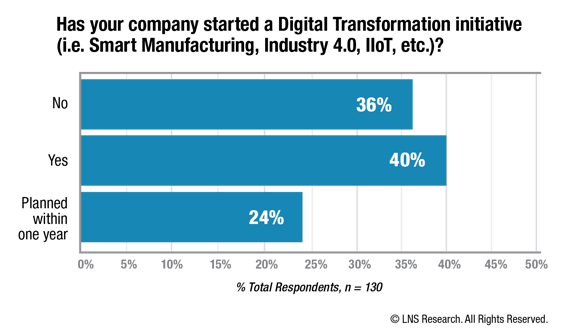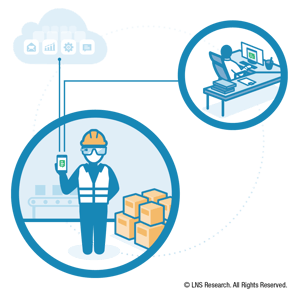Digital Transformation is a widespread trend across industry. Our research shows that about two-thirds of industrial organizations have already implemented Smart Manufacturing and Industry 4.0 technologies, or plan to soon. This trend is only accelerating. To date, most companies have focused digitalization investments on using asset- and operations-related data to improve core operational areas such as asset reliability, energy management, and production efficiency.
 We have seen a considerable adoption of Cloud-based software, mobile applications, and advanced analytics as the core technology platform for environment, health, and safety (EHS) management. However, the implementation of Industrial Internet of Things (IIoT) scenarios incorporating smart connected devices and sensor-generated data for EHS use cases is at an earlier phase of market adoption.
We have seen a considerable adoption of Cloud-based software, mobile applications, and advanced analytics as the core technology platform for environment, health, and safety (EHS) management. However, the implementation of Industrial Internet of Things (IIoT) scenarios incorporating smart connected devices and sensor-generated data for EHS use cases is at an earlier phase of market adoption.
There is tremendous untapped potential to apply emerging digital technologies to mitigate risk and improve workplace safety. Technologies such as intelligent wearables, proximity beacons, and smart connected devices together with mobile applications enable the connected worker. This is a significant opportunity for EHS and operations leaders to add more value to the business by better engaging, connecting, and informing workers.
Enabling the Connected Worker
The potential for digital innovation to improve safety and operational performance is excellent. However, merely applying technology is not inherently useful. The real value is the interaction of technology with the total organizational system and the people and processes comprising it.
There are three main technology adoption phases organizations typically go through in their EHS Digital Transformation journeys. The first phase is establishing a foundation by replacing spreadsheets and point solutions with Cloud-based enterprise software to manage data, workflows, and reporting. The second phase is extending those capabilities further into the enterprise with mobile applications that enable and engage the workforce. And, the third phase is enhancing mobile capabilities with advanced digital technologies, allowing the truly connected worker.
 Mobility is a technology game-changer because it affects how people interact with their work environment. Mobile applications extend critical information and workflows to wherever work gets done, from the plant floor to remote field locations. Mobile devices help people more actively engage with work processes and management systems; perform tasks with higher efficiency and safety, and access business applications such as maintenance, quality, and EHS management, where and when needed.
Mobility is a technology game-changer because it affects how people interact with their work environment. Mobile applications extend critical information and workflows to wherever work gets done, from the plant floor to remote field locations. Mobile devices help people more actively engage with work processes and management systems; perform tasks with higher efficiency and safety, and access business applications such as maintenance, quality, and EHS management, where and when needed.
Advanced digital technologies can help make mobile applications easier to use, further automate workflows and information delivery, and capture more data that can be analyzed to predict and prevent incidents and accidents. Use cases include augmented reality-enabled smart glasses to deliver safe work procedures on the shop floor, proximity beacons that trigger the delivery of relevant hazard communication information to a worker’s mobile device upon entering a work area, and IIoT-enabled personal and area hazardous gas monitoring. Industrial organizations are benefiting from such technologies today, as evidenced by the 51% of organizations that report they use intelligent wearables in plant operations.
Recommendations for Moving Forward
Forward-thinking EHS leaders can take advantage of digitalization in practical, low-risk ways. Here are four suggestions to help get started with a connected worker initiative:
- Focus on a specific problem. Identify a pain point and the business value of addressing it. Connected worker use cases are often well-suited for limited-scope, low-cost pilot projects that deliver value relatively quickly.
- Leverage enterprise Digital Transformation initiatives. Learn about your organization’s digitalization initiatives and capabilities. Look for opportunities to incorporate connected worker projects into the mix.
- Consider foundational capabilities. Readiness for a connected worker project will depend on current capabilities, including technology. Integrated scenarios that extend enterprise Cloud-based software applications with mobile applications deliver the highest value.
- Address privacy and data security up front. Stay cognizant of the data privacy and security issues for people-related data; legal requirements vary by country. Many organizations have a policy to govern data. Data privacy and security is manageable when addressed proactively before going too far.